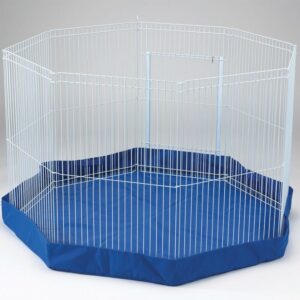Ferrets are really social and need a time out of their cages for playtime and exercise. Thoughtful ferret-proofing is an outright requirement. When coming close to ferret-proofing, keep in mind that ferrets are really interested, will chew and ingest plastic and rubber items that are dangerous for them to eat.
Ferret-proofing is a recurring task, rather than a single duty. Despite just how thoroughly you ferret-proof, you must still carefully supervise your family pet ferrets as you never understand what they might try to enter following! Watch what your ferrets intend to get involved in, and make modifications as essential.
These are some general suggestions to keep in mind when ferret-proofing your house.
Ferret-Safe Rooms
If it is possible, a good way to ferret proof is to have a single space that is completely and totally ferret-proofed, in which you can let your ferrets prance with the door shut to obstruct access to the rest of your residence. If this is not possible, you can ferret proof a bigger location, however, try to block access to the kitchen area, restroom, and also utility room, as these are locations that are more challenging to ferret-proof.
Protect against Escapes
Make sure they can not get outside. They can conveniently tear through a window screen, so keep windows shut at all times. Ideally, see to it that when your ferrets are out, they can not reach doors that lead to the outside. Your ferret could dart out; at least lock the doors when ferrets are playing if a person unintentionally opens up a door. You must also check for any tiny openings to the outdoors (e.g. around plumbing, the clothes dryer vent, etc) and also ensure they can not venture out under doors. Remember, ferrets can squeeze with surprisingly little effort into tiny spaces.
Home appliances
Ferrets can conveniently get under many devices as well as get into the home appliances, which can be hazardous if the home appliance is switched on or if located near electric wires. Besides, ferrets are very drawn into baskets of washing, and might accidentally be put in the washing machine (or clothes dryer) with a basket of garments. A ferret that makes his or her method right into the dryer vent air duct now has an escape hatch! If your ferret has accessibility to these rooms, you must locate a method to block off the undersides and backs of the appliances, as well as you should ascertain the interiors of all devices before utilizing them or closing them.
Furnishings
Furnishings are one more favorite of ferrets for getting under and after that going up right into the inner workings. It is a great idea to secure essential heavier material to the undersides of box spring bed mattress as well as couches and also chairs, as ferrets can conveniently get through the lightweight fabric usually made use of below. Recliner chairs are really hazardous to ferrets, as the reclining mechanism can trap and also significantly hurt ferrets hiding under the chair. Similarly, rocking chairs are a negative idea around ferrets. You likewise need to check sofa cushions before you sit down as ferrets might burrow under or even right into them. Cushions ought to likewise be checked in case the ferrets are getting into them and also eating on the foam (a threat for intestinal obstructions).
Watch What They Eat What.
A common clinical problem is blockages in the digestion system from something a ferret has actually swallowed, especially in packages. Ferrets will chew out and also ingest a shocking selection of items, but points like foam, styrofoam packaging, soft rubber toys, neoprene, erasers, elastic bands, and rubber squeaky playthings are among some of the most troublesome. Indigestible products ingested by ferrets can obstruct the digestion system and require surgery to remove them. You need to likewise see that they do not ingest poisonous compounds, like cleansers, harmful plants, medicines, and so on.
Appliances – Accessibility to laundry as well as a kitchen if possible. If not, block off devices (fridge, range, dishwasher, washing machine, dryer, freezers) to make sure that ferrets can not get under them or into the areas (e.g. where the electric motor or cords lie). Double-check for concealing ferrets before transforming appliances on or shutting their doors.
Clothes hamper – Check the laundry before putting it in a washer or clothes dryer.
Clothes dryer vents – Safeguard the clothes dryer duct (look for chewing into the air duct) or you might use it to obtain outdoors or into the clothes dryer.
Duct – Guarantee your ferrets can not get into the heating/air ducts or they might obtain stuck, injured, or wind up outdoors.
Boxspring bed mattress – Securely cover the bottom with heavy fabric or timber to avoid ferrets from climbing into the box spring.
Recliners – Always see to it your ferrets are no place near the systems when using recliners, or even better, do not use them when your ferrets are out.
Shaking chairs – It is best to stay clear of these when ferrets are out. Sofas, chairs – Secure the bottoms to avoid ferrets from obtaining under and also up into the furnishings. Also examine under the cushions before resting, to make certain an isn’t napping under them. Utilizing slipcovers will stop ferrets from delving right into the cushions. Regularly check sofa cushions, furnishings, and pillows for indications of chewing.
Small areas – Make certain there are no tiny spaces whereby your ferret might leave your house or into the walls. Keep in mind, if they can obtain their heads into a fracture, their bodies can generally comply with it. Specifically examine cupboards, pipes, ducts, doors, and so on. Under doors – Watch for large rooms that ferrets can survive. Also, to prevent ferrets from trying to remove through the carpeting under doors, you can put a plastic chairmat (can be cut to fit), slim plexiglass, or linoleum under the door (but expect to chew on these).
Windows – See to it any obtainable windows are closed when ferrets are out. Ferrets can quickly bite with window displays.
Bathrooms – Drowning risk. Keeping ferrets out of the bathroom is the safest total, but definitely maintains commode seats down. Ferrets might try to get a beverage and fall in.
Standing water – Comparable to bathrooms, a sink, bathtub, or perhaps pail of water poses a drowning threat.
Cleansing materials – Many cleansing chemicals are dangerous or poisonous to curious ferrets. Keep purely unreachable.
Cupboards – A lot of ferrets will quickly enter your cabinets. Buy the magnetic sort of kid proofing locks for cupboards (a lot of the plastic locks permit the cabinets to open a little bit, which is enough for the majority of ferrets to get in).
Electrical cables – Enclose in plastic tubing to avoid eating.
Houseplants – Do not maintain dangerous plants, and also keep other plants out of reach (ferrets will dig in the dirt and could chew the plants).
Knick-knacks – Ensure breakable or fragile products are out of reach, and that there are no heavy things that could fall or be pulled over onto yours.
Cabinets, as well as High Tables – Ferrets, like to climb as well as on points, but frequently can’t climb down. Nonetheless, their absence of fear will certainly usually make them try jumping also from heights, see to it there is no high furniture to obtain stuck on.
Open up barriers – Around stairs etc.; lack of concern may cause drops.
Trash – Safely cover or stay out of reach.
Chewing and Consuming – Look for things that you could chew and also ingest – specifically points like foam, soft rubber or plastic, styrofoam, sponges, rubber bands, pen caps, cotton swabs, fabrics, and more. Remote buttons are a preferred target.
Followers, Space Heaters, Candles, Fireplaces – Keep ferrets far from these.
Toys – Check occasionally to make sure they are not being taken down as well as eaten.


